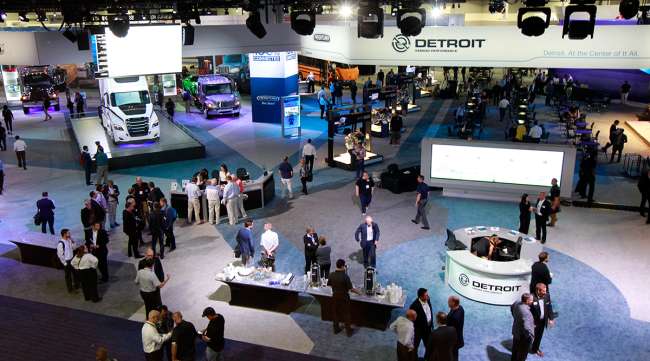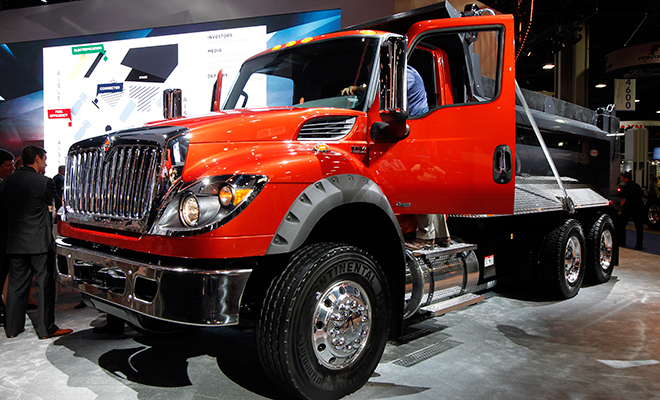Inaugural NACV Draws Top Fleet Execs, Praise

ATLANTA — North American truck makers and their customers wrapped up the first of a new option for shopping for and even buying Class 8s, with manufacturers producing large, elaborate displays for a limited number of high-probability buyers: top fleet executives.
The North American Commercial Vehicle Show ran here Sept. 25-28 for nearly 10,000 attendees who traipsed across 379,300 square feet of exhibits in the Georgia World Congress Center to check out what’s available in the truck market today and what’s planned for in the coming years. Five of the seven heavy-duty truck brands were the stars, but there were also top-tier suppliers to answer questions about their products.
Trucking executives who spoke to Transport Topics said there was more shopping than buying, but shopping of consequence.
NACV COVERAGE: All stories | Live blog | Photo gallery
U.S. Xpress Enterprises is preparing for the truckload carrier’s 2018 truck buy, some 1,500 to 2,000 tractors.
“I’m in the middle of negotiations,” said Max Fuller, the company’s chairman. “We’ll complete this in the next three-to-six weeks,” he said, adding that his two-day visit was “extremely useful.”
Fuller said he visited with truck, engine, transmission and tire makers. Then he looked into air disc brakes. “It’s a good place to compare products,” he said.
Marten Transport Chairman and CEO Randolph Marten said, “It reminded me of the Hanover [Germany] show last year, where it was all set up with everything they made.”
He said he did not go to buy vehicles, but that there was time for detailed conversations with supplier executives.
In just one day there, Marten said, he met with three truck makers, major producers of refrigeration units Thermo King and Carrier Transicold, and some others. His Mondovi, Wis.-based company is the fifth-largest refrigerated carrier in North America.
“If you wanted to know something, you could get it answered,” Marten said.
Bill Reed, CEO of Skyline Transportation in Knoxville, Tenn., also attended for one day and said he shopped for trucks that emphasize driver amenities. He said he was “impressed” with the event and that it offers benefits for both sides.
“I could do a lot of comparison shopping, and the OEMs had all of their customers in one place,” Reed said, referring to original equipment manufacturers. He did not make any purchases during the show, but Reed said he’ll be buying trucks during the first quarter of 2018 and the NACV visit will help with the process.
NACV is scheduled to run in odd-numbered years and was set up as an alternative to the larger, older Mid-America Trucking Show that convenes annually in Louisville, Ky.
“For a first edition, we’re happy but not satisfied. We know there are improvements to be made,” said Joe Glionna, president of NewCom Business Media, the Canadian half of the joint venture that created the NACV.
The other partner is Germany’s Deutsche Messe, with U.S. arm Hannover Fairs.
The show had 452 exhibitors who occupied 441 booth spaces. Some corporations with multiple brands put more than one exhibit in a booth. Glionna said he did not quite get the 10,000 visitors that he was hoping for, but “came close.” Final attendance figures will be published Oct. 2, he said.
“We are extremely happy with the turnout of the show,” said Jeff Sass, senior vice president of sales and marketing for Navistar Inc. “We had the right customers there, heavy booth traffic and were proud to be a part of the inaugural year of this show. We’re already looking forward to 2019.”
“The goal of the show, I think, is really excellent, in terms of connecting with fleets and connecting with customers,” said Jon Morrison, president of Wabco Holdings’ Americas division.

Navistar HV severe service model by John Sommers II for Transport Topics
Except for a new Navistar vocational model, all of the trucks on display had been introduced before the show, but Glionna said he expects that to change.
“Some of the plans for new trucks are three or four years in the making,” so synchronization with 2017 NACV was not possible, he said. “But two years from now we’re definitely going to see truck and innovation launches,” Glionna said.
As for innovation, there was consistency on what will come: autonomous, connected and electric vehicles.
Connectivity has made the most progress so far, with all truck makers emphasizing in-truck telematics as one of the most important tools for not just preventive maintenance, but predictive fixes and improvements. Freightliner, Mack, Navistar, Volvo and Western Star all mentioned it.
Electric vehicles are coming, all manufacturers said, but Class 8 highway tractors might take the longest. Medium-duty trucks, such as Class 6 or Class 7 models mentioned by Navistar, seem more likely to come first.
But a Daimler executive said his company would like to one day make and sell a “Cascadia-E” electric tractor.
.@Daimler_CV CEO Martin Daum: I can't wait to add a big "E" on end of a Cascadia or Western Star truck. #NACV2017 pic.twitter.com/W28cud3cmv — Seth Clevenger (@SethClevenger) September 25, 2017
Manufacturers said workable battery packs are becoming less expensive and less bulky over time due to much research.
The autonomous angle was couched in terms of systems that assist drivers, rather than replace them.

